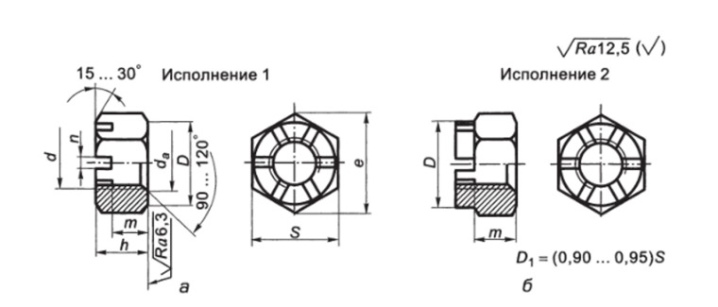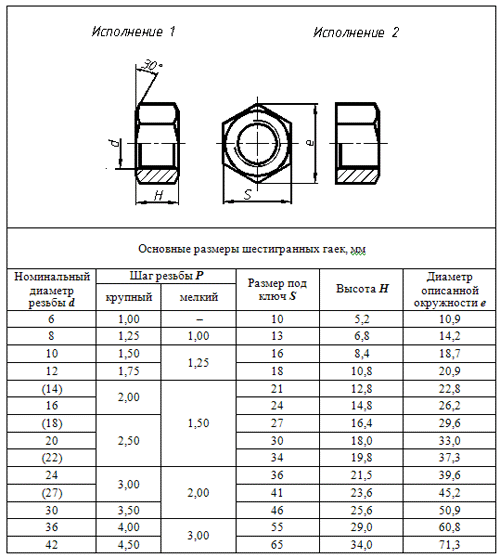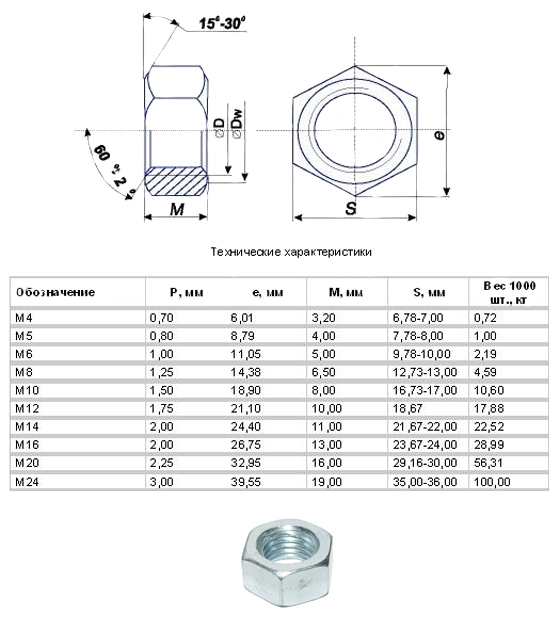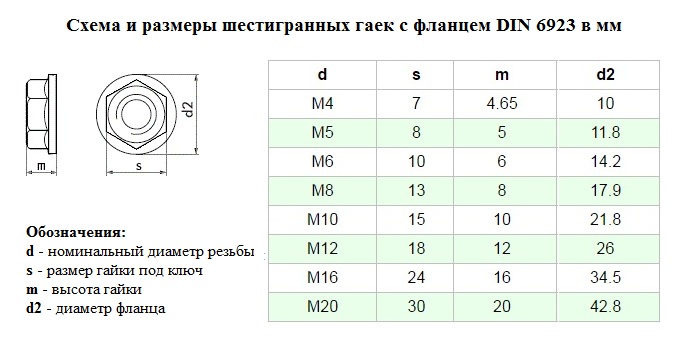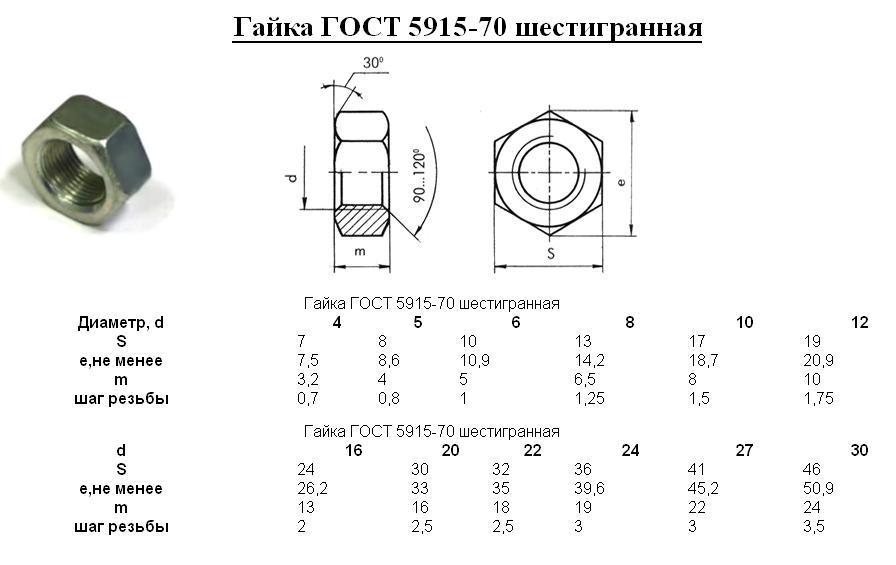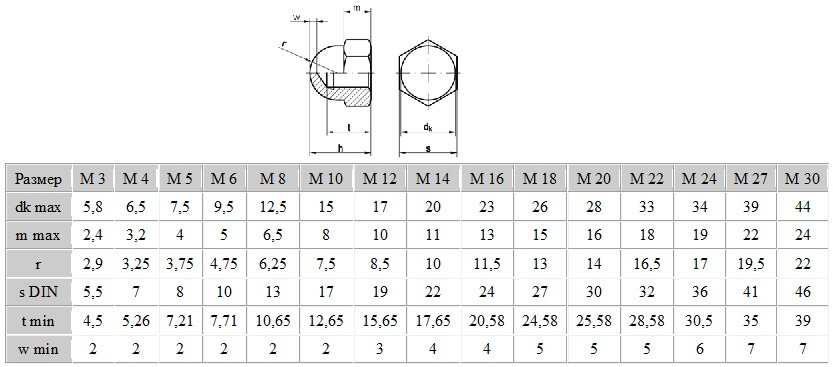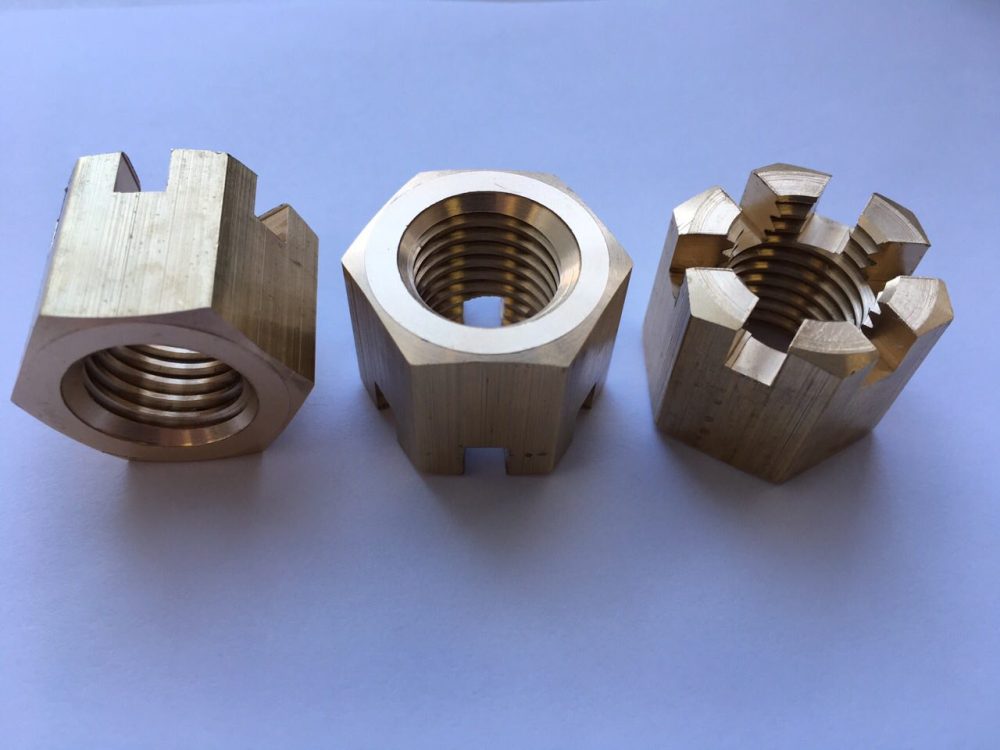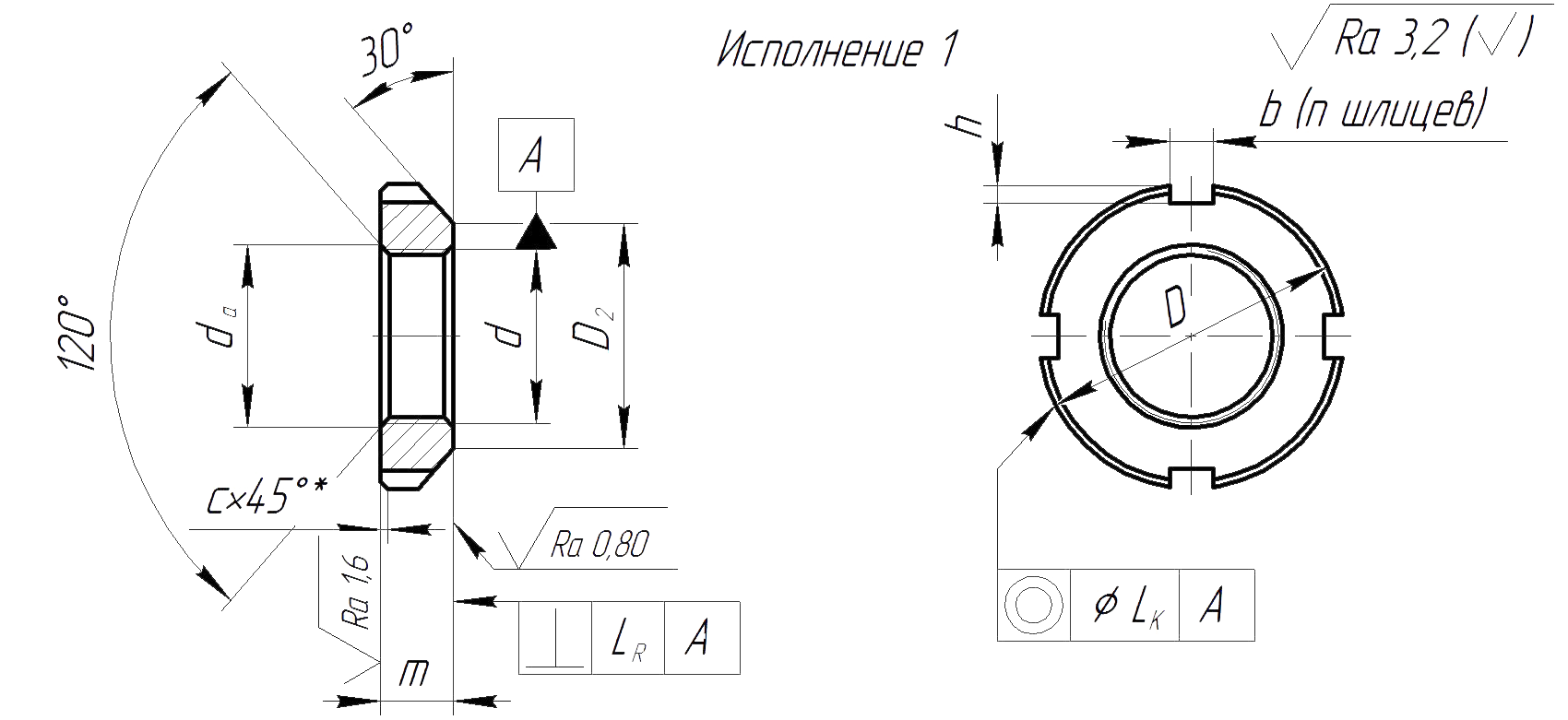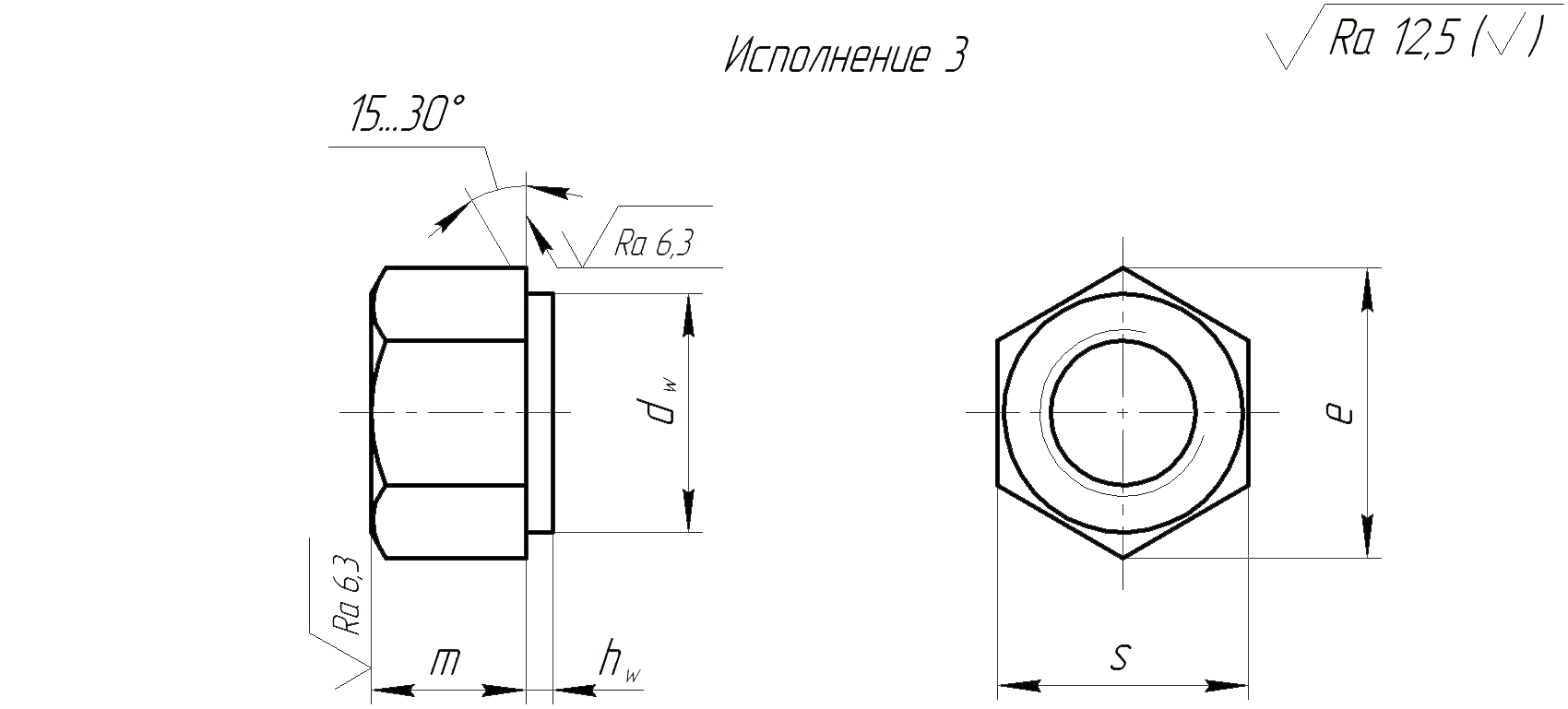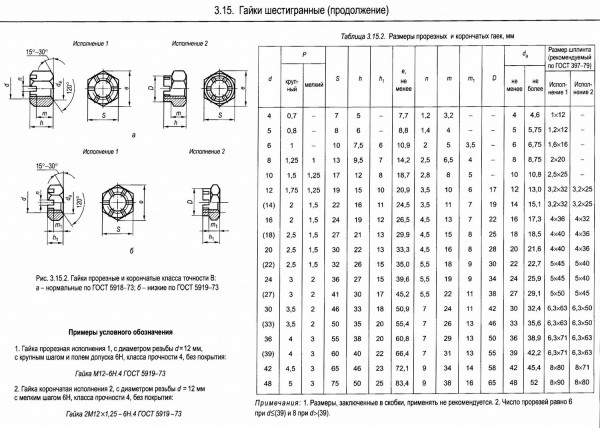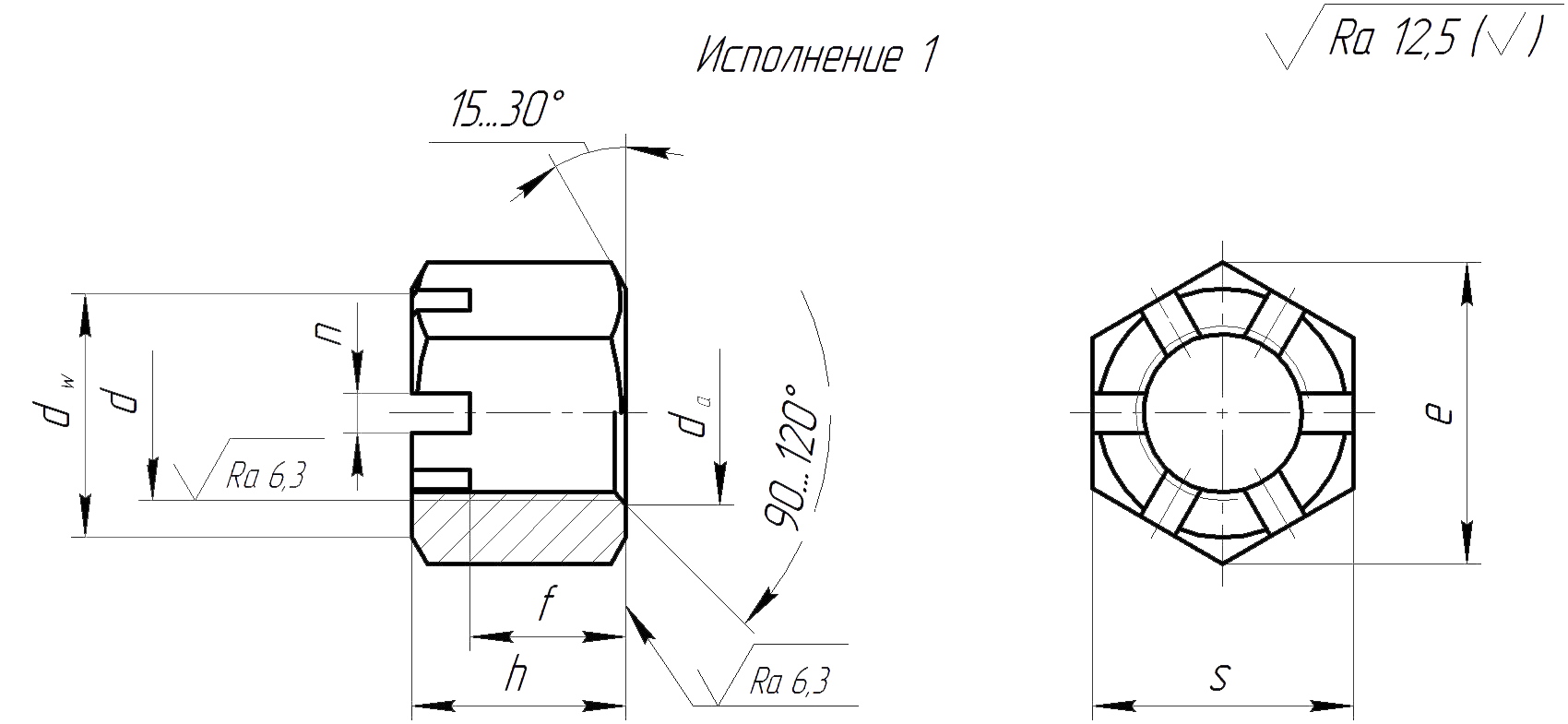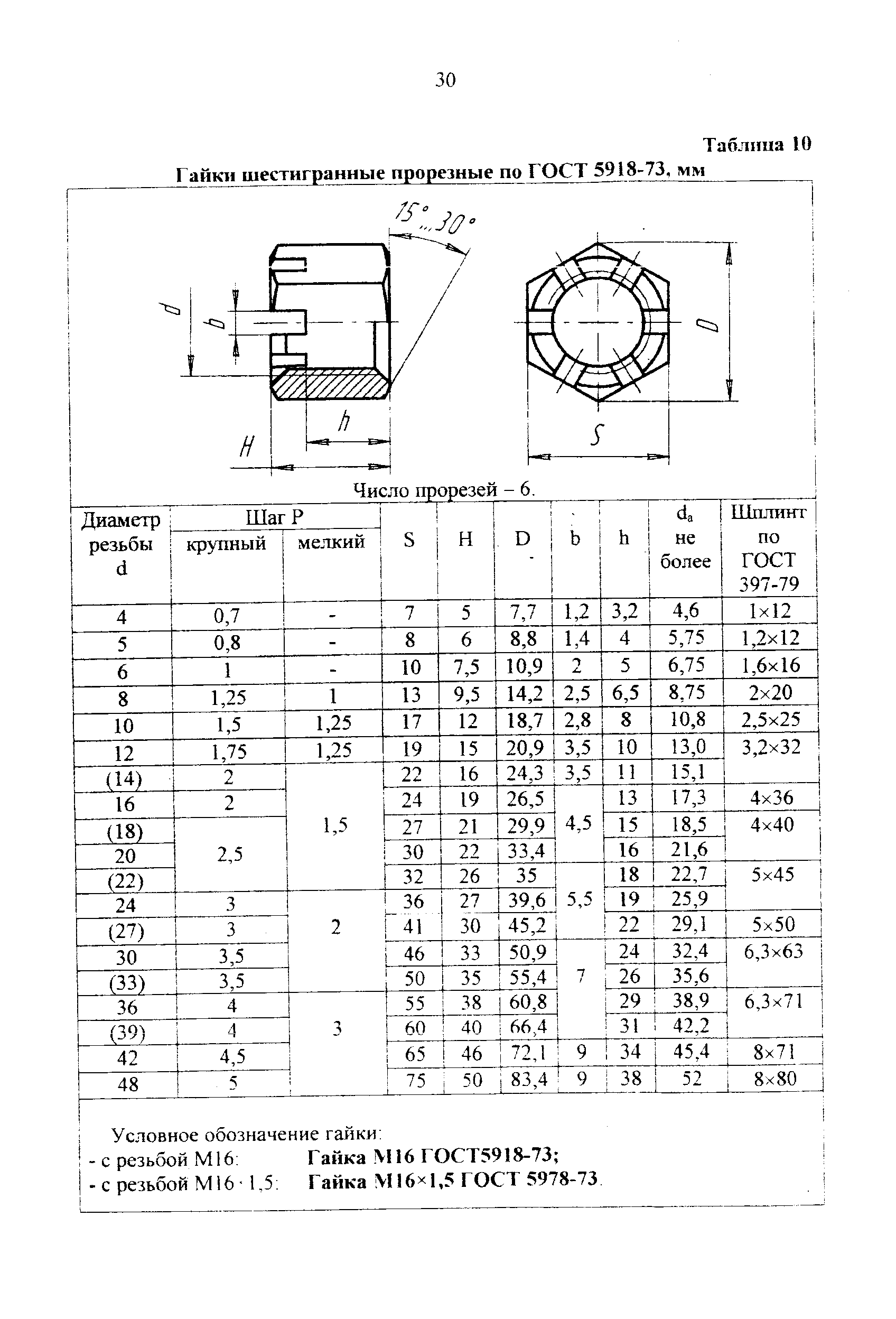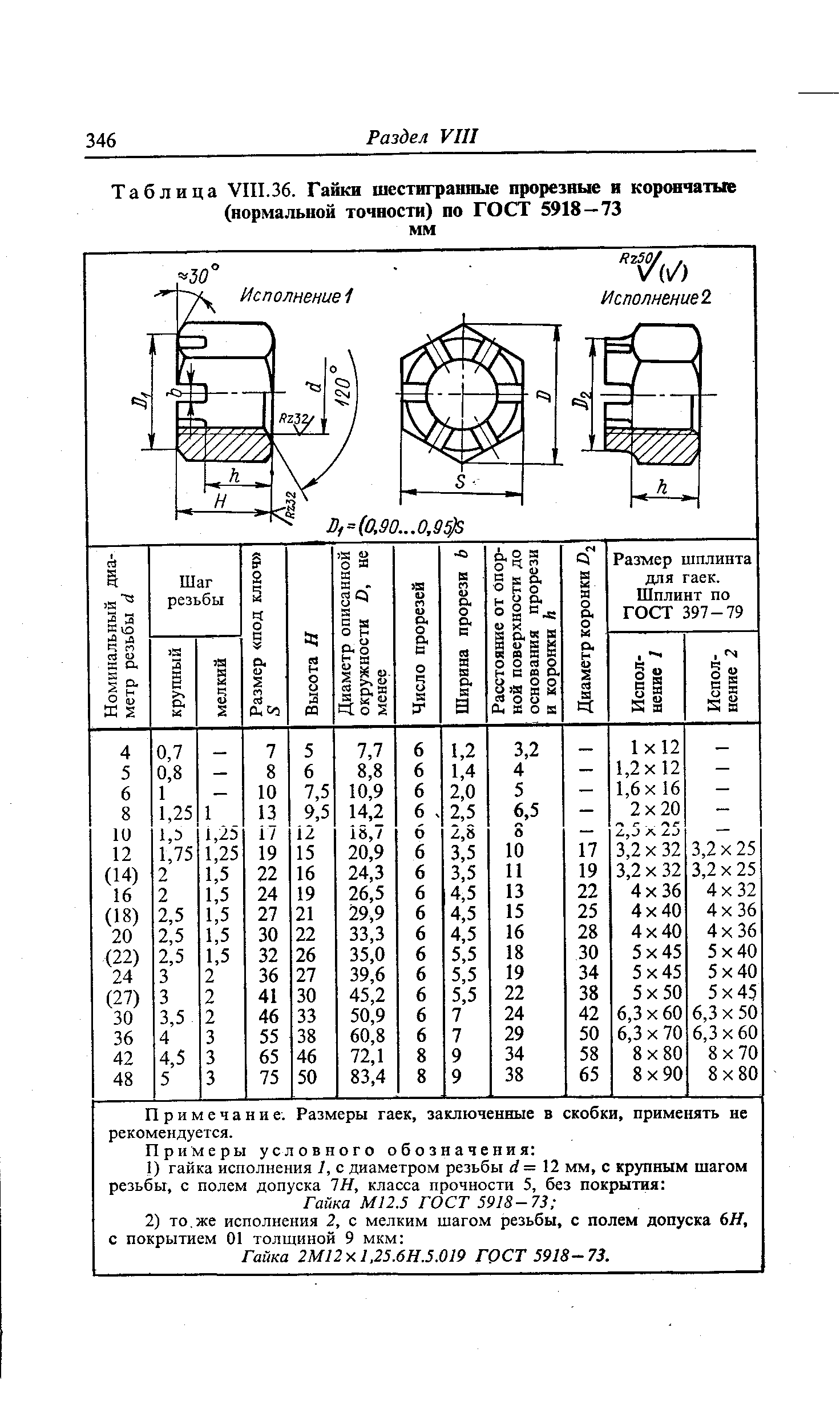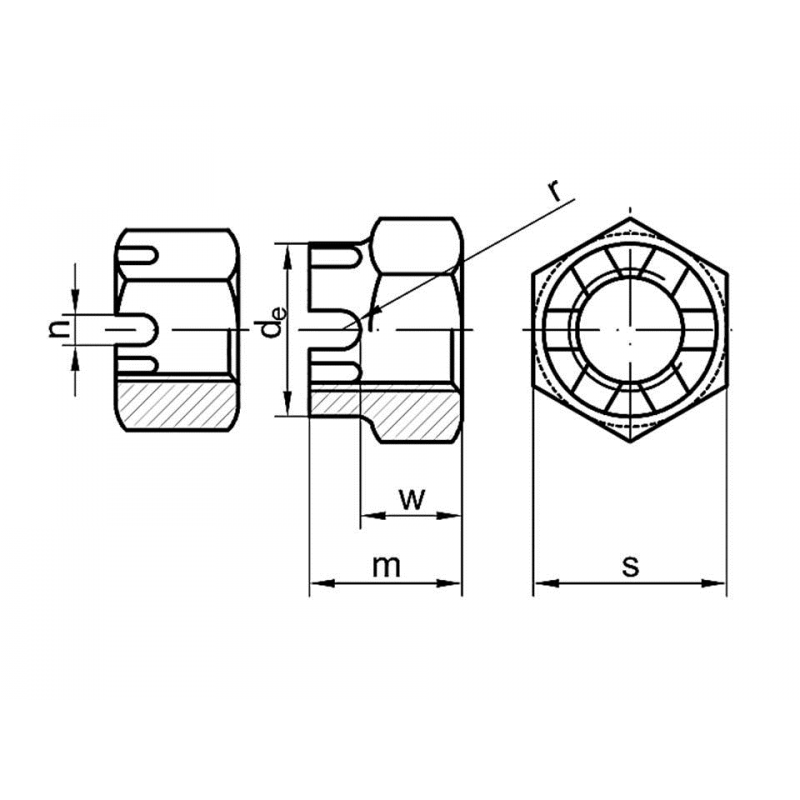(Changed edition, Amendments No. 1, 2, 3, 4, 5).
2. Thread - in accordance with GOST 24705.
(Modified edition, Amendment No. 4).
3. It is allowed to make a chamfer from the side of the slot or crown.
Per. The shape of the bottom of the slot can be flat, rounded or chamfered. (Introduced additionally, Amendment No. 3).
4. Technical requirements - according to GOST 1759.0.
5. The theoretical mass of nuts is indicated in Appendix 1.
APPENDIX 1 Reference
Weight of steel nuts with coarse thread
table 2
|
Nominal thread diameter d, mm |
Theoretical weight 1000 pcs. nuts, kg |
Nominal thread diameter d, mm |
Theoretical weight 1000 pcs. nuts, kg |
||
|
Execution 1 |
Execution 2 |
Execution 1 |
Execution 2 |
||
|
6 |
2,473 |
_ |
24 |
76,349 |
67,810 |
|
8 |
4,789 |
— |
27 |
116,110 |
103,260 |
|
10 |
9,055 |
— |
30 |
152,560 |
132,570 |
|
12 |
13,129 |
11,096 |
33 |
200,715 |
175,525 |
|
14 |
20,186 |
16,940 |
36 |
248,870 |
218,480 |
|
16 |
26,078 |
22,490 |
39 |
313,540 |
271,320 |
|
18 |
37,303 |
32,850 |
42 |
378,210 |
324,160 |
|
20 |
46,315 |
40,960 |
48 |
570,480 |
486,140 |
|
22 |
66,578 |
59,630 |
APPENDIX 1. (Modified edition, Amendment No. 5).
APPENDIX 2 Reference
Table 3 mm
|
Nominal thread diameter d |
10 |
12 |
14 |
22 |
|
Turnkey size S |
17 |
19 |
22 |
32 |
|
Diameter of the circumscribed circle e, not less |
18,9 |
21D |
24,5 |
35,8 |
|
d, not less w ’ |
15,6 |
17,4 |
20,6 |
30,0 |
APPENDIX 2. (Introduced additionally, Amendment No. 5).
4-2107
INFORMATION DATA
1. DEVELOPED AND INTRODUCED by the USSR State Committee for Standards
2. APPROVED AND INTRODUCED INTO EFFECT by the Resolution of the State Committee of Standards of the Council of Ministers of the USSR No. 141 dated 23.01.73
3. The standard fully complies with ST SEV 2663-89
The standard corresponds to the international standard ISO 4032-79, ISO 4035-79 in terms of turnkey dimensions
4. REPLACE GOST 5933-62
5. REFERENCE REGULATORY AND TECHNICAL DOCUMENTS
|
Designation of NTD referenced |
Item number |
|
GOST 397-79 |
1 |
|
GOST 1759.0-87 |
4 |
|
GOST 24705-2004 |
2 |
6. The limitation of the period of validity was removed according to the protocol No. 4-93 of the Interstate Council for Standardization, Metrology and Certification (IUS 4-94)
7. EDITION with Amendments No. 1, 2, 3, 4, 5, 6, approved in February 1974, September 1979, December 1981, October 1984, March 1989, March 1990 ( IUS 3-74.10-79, 2-82.1-85, 6-89, 7-90)
Design and dimensions
Hexagon thin slotted and castle nuts, accuracy class A. Construction and dimensions
GOST
5933-73
ISS 21.060.20 OKP 45 9500 * 1
Date of introduction 01.01.74
This standard applies to class A low slot and castle hex nuts with thread diameters from 6 to 48 mm.
The standard is fully consistent with ST SEV 2663-89.
(Modified edition, Amendment No. 3).
1. The design and dimensions of the nuts must correspond to those indicated in the drawing and in the table. Version 1 Version 2

Official edition ★
Reprinting prohibited
Table 1
mm
|
Nominal thread diameter d |
6 |
8 |
10 |
12 |
(14) |
16 |
(18) |
20 |
(22) |
24 |
(27) |
30 |
(33) |
36 |
(39) |
42 |
48 |
|
|
Thread pitch |
large |
1,0 |
1,25 |
1,5 |
1,75 |
2,0 |
2,0 |
2,5 |
2,5 |
2,5 |
3,0 |
3,0 |
3,5 |
3,5 |
4,0 |
4,0 |
4,5 |
5,0 |
|
small |
— |
1,0 |
1,25 |
1,25 |
1,5 |
1,5 |
1,5 |
1,5 |
1,5 |
2,0 |
2,0 |
2,0 |
2,0 |
3,0 |
3,0 |
3,0 |
3,0 |
|
|
Turnkey size S |
10 |
13 |
10 |
18 |
21 |
24 |
27 |
30 |
34 |
30 |
41 |
46 |
50 |
55 |
00 |
05 |
75 |
|
|
Height h |
7 |
8 |
10 |
11 |
12 |
13 |
13 |
15 |
15 |
17 |
18 |
20 |
20 |
22 |
23 |
25 |
||
|
Distance from the supporting surface to the base of the slot / and the crown w |
3,5 |
4,0 |
5,0 |
6,0 |
7,0 |
7,0 |
8,0 |
8,0 |
9,0 |
9,0 |
11 |
11 |
13 |
13 |
13 |
14 |
16 |
|
|
d, not less I1 ' |
9,0 |
11J |
14,0 |
16,6 |
19,0 |
22,5 |
25,3 |
27,7 |
31,7 |
33,2 |
38,3 |
42,7 |
40,0 |
51,1 |
55,9 |
00,6 |
09,4 |
|
|
Diameter of the circumscribed circle e, not less |
11,1 |
14,4 |
17,8 |
20,0 |
23,4 |
26,8 |
30,1 |
33,5 |
37,7 |
40,0 |
45,6 |
51,3 |
55,8 |
01,3 |
67,0 |
72,6 |
83,9 |
|
|
Diameter |
not less |
6 |
8 |
10 |
12 |
14 |
16 |
18 |
20 |
22 |
24 |
27 |
30 |
33 |
36 |
39 |
42 |
48 |
|
chamfers da |
no more |
0,75 |
8,75 |
10,8 |
13,0 |
15,1 |
17,3 |
19,4 |
21,6 |
23,8 |
25,9 |
29,2 |
32,4 |
35,6 |
38,9 |
42,2 |
45,4 |
51,8 |
|
Crown diameter D |
— |
— |
— |
16 |
19 |
22 |
25 |
28 |
32 |
34 |
38 |
42 |
40 |
50 |
55 |
58 |
65 |
|
|
Number of slots |
6 |
8 |
||||||||||||||||
|
Slot width w |
2,0 |
2,5 |
2,8 |
3,5 |
4,5 |
5,5 |
7,0 |
9,0 |
||||||||||
|
The size cotter pin (re- |
Execute nie! |
1,616 |
2-20 |
2,5-25 |
3,2-32 |
4-36 |
4-40 |
5-45 |
5-50 |
6,3-63 |
6,3-71 |
8-80 |
8-90 |
|||||
|
recommended) according to GOST 397 |
Execution 2 |
— |
— |
— |
3,2-25 |
4-32 |
4-30 |
5-40 |
5-45 |
0,3 |
-50 |
0,3-63 |
8-71 |
8-80 |
Notes:
L Dimensions in parentheses are not recommended.
2, It is allowed, by agreement between the manufacturer and the consumer, to manufacture nuts with a nominal thread diameter of 36 to 48 mm with a thread pitch of 2 mm.
3. For products designed before 01.01.91, it is allowed to use nuts with the dimensions specified in Appendix 2.
N
GOST S933-73 S.
example of the symbol for a nut of version 1, thread diameter d = 12 mm, with a large thread pitch with a tolerance field of 6H, strength class 04 without coating:
Nut М12-6Н. 04 GOST 5933- 73
The same, version 2, with a fine thread pitch with a tolerance field of 6H, with a coating of 01 with a thickness of 9 microns:
Nut 2M12 ■ 1.25-6N.04.019 GOST 5933-73
Peculiarities
This is a type of metal products with an internal thread, intended for fastening parts in particularly critical places.
Externally, a castellated nut looks like a hexagon with slots cut vertically (the number of splines can be different, this is affected by the diameter of the threaded connection). Because of this unusual appearance, it got its name. These "teeth" are the main feature of this fastener.
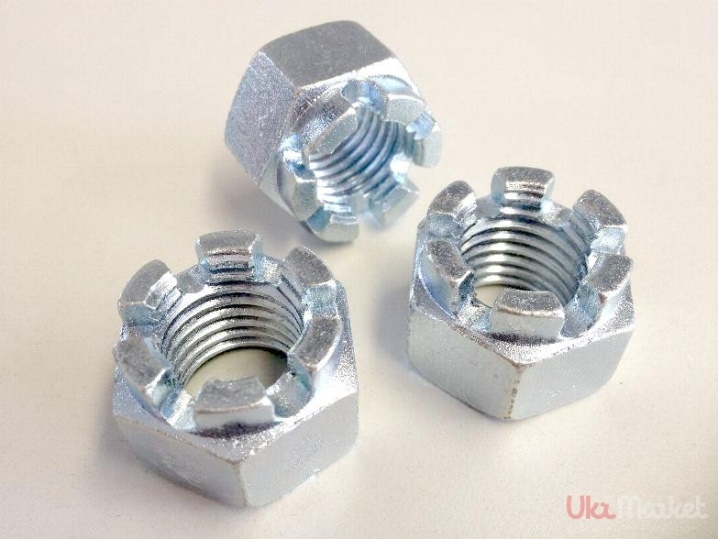
There is a special hole in the bolt, after screwing the nut, a cotter pin is inserted into it, or it is fixed with a safety wire. As a result of these manipulations, the connection gains additional reliability.
And also crown products are characterized by increased complexity of manufacture. This process takes much longer than the release of conventional nuts with the used stamping or casting methods.
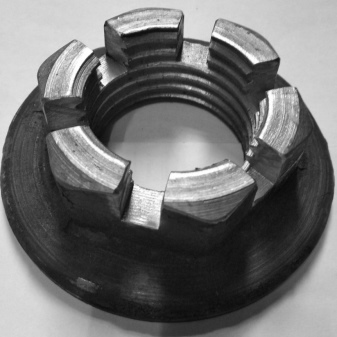
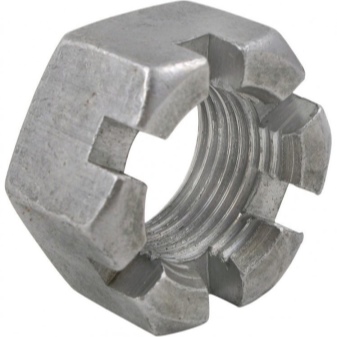
The most common method for the production of castellated nuts looks like this: a multifaceted bar of the required diameter is taken, blanks are cut and subsequently processed mechanically. Because of these additional complications during production, products of this type are more expensive.
Applications
Before purchasing castellated nuts, it is very important to determine the environment of use and purpose. If the fasteners will be used under normal conditions, then you can purchase and use hardware from ordinary steel
In the event that the surrounding atmosphere suggests unfavorable circumstances, it is advisable to use products made of materials that are resistant to corrosion. And if the environment is chemically aggressive, stainless steel or non-ferrous metal options are best. All castle nuts are available in different designs.
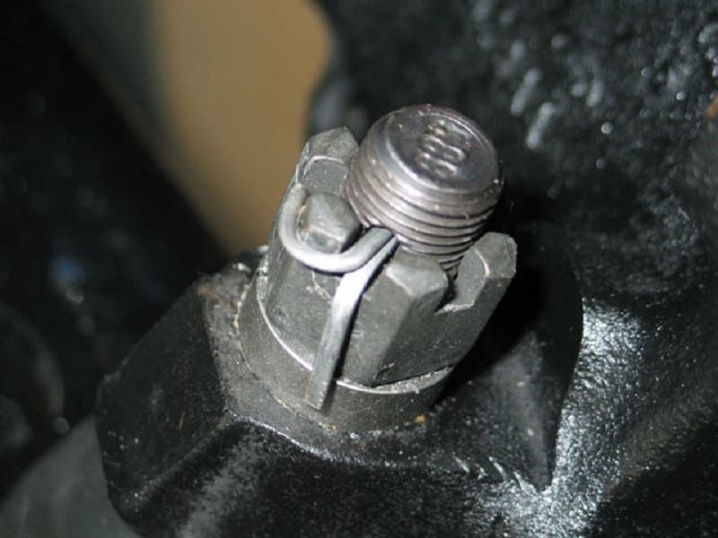
These fasteners are widely used in various industries, very often found in everyday life. They have proven themselves most well in the automotive, carriage-building areas of production. They are also irreplaceable in mechanisms that constantly face high loads or increased vibration.
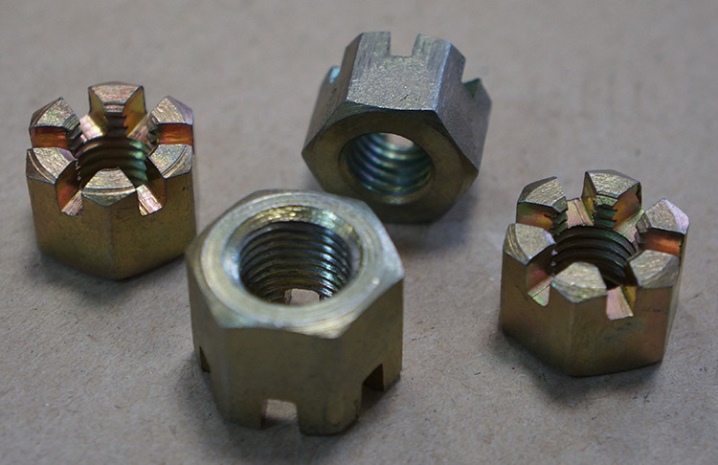
In the following video, you will learn how you can use a castellated nut.
Views
The main regulatory document according to which castellated and low slotted nuts are manufactured is GOST 5918-73. And also the European standard DIN 935 is used, according to which a product is considered to be slotted up to a thread diameter of M10, and above it is a castellated one.
All fasteners are divided into three types according to the accuracy class:
- A (increased);
- B (normal);
- C (reduced).
The castellated nut belongs to class B.
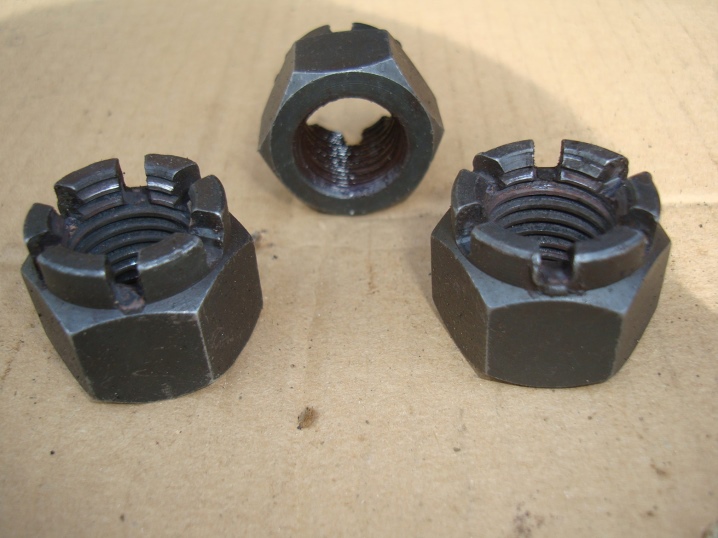
Another characteristic is strength. There are 7 strength classes in total, but in real life, professionals usually identify products with normal strength and high. Experts say: for a long service life of a threaded connection, it is necessary that bolts and nuts correspond to the same strength class. And for maximum reliability, the fastener should be more reliable than the bolt, at least one step and secured with a cotter pin.
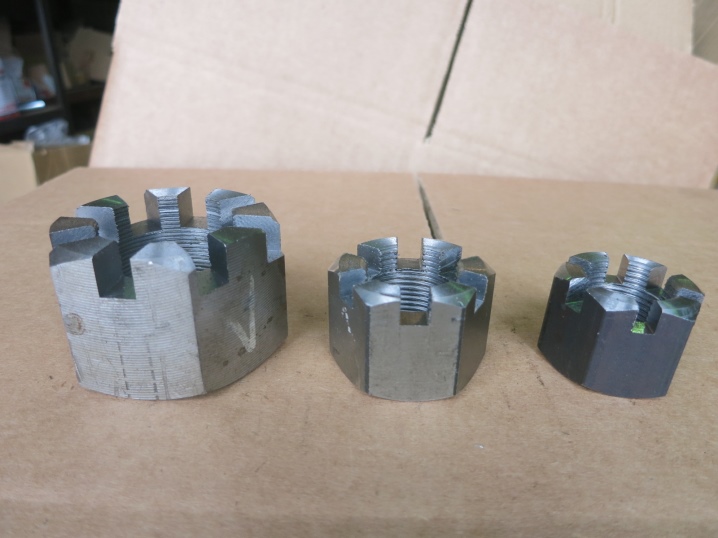
The third parameter is height. Nuts can be low, high or elongated. The height of the product is determined according to the following principle: 0.5-0.6 thread diameters for small ones, for the second type - 1.5, for increased ones - 3.
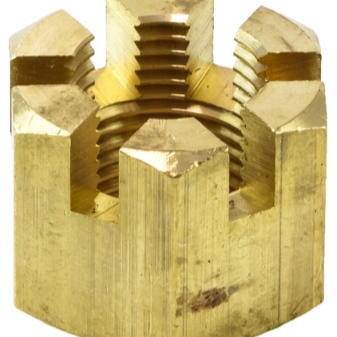
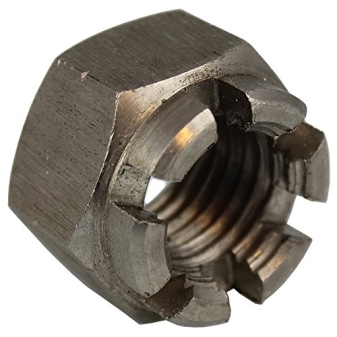
Slotted and crown hardware are available in low and regular versions.
The material from which these products are made: these are various types of steel - both conventional and stainless, non-ferrous metals or plastic.
The shape of the products is mainly hexagonal, but octahedrons are also found. And also they can be structurally performed in two types, with a chamfer (version 2) and without (version 1).
